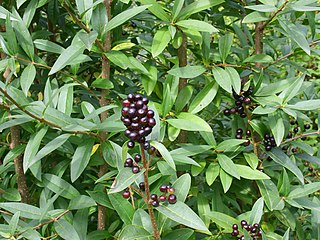
A privet is a flowering plant in the genus Ligustrum. The genus contains about 50 species of erect, deciduous or evergreen shrubs, sometimes forming small or medium-sized trees, native to Europe, north Africa, Asia, many introduced and naturalised in Australasia, where only one species extends as a native into Queensland. Some species have become widely naturalized or invasive where introduced. Privet was originally the name for the European semi-evergreen shrub Ligustrum vulgare, and later also for the more reliably evergreen Ligustrum ovalifolium and its hybrid Ligustrum × ibolium used extensively for privacy hedging, though now the name is applied to all members of the genus. The generic name was applied by Pliny the Elder to L. vulgare. It is often suggested that the name privet is related to private, but the OED states that there is no evidence to support this.
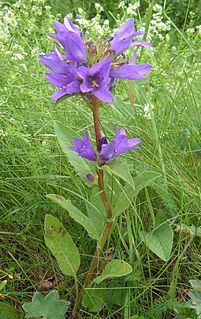
Campanula glomerata, known by the common names clustered bellflower or Dane's blood, is a species of flowering plant in the genus Campanula, belonging to the family Campanulaceae. It is the county flower of Rutland, England.

Kuding or kuzding is a particularly bitter-tasting Chinese infusion, which due to their similarities in appearance is derived from several plant species. The two most common plants used to make kuding are the wax tree species Ligustrum robustum and the holly species Ilex kaushue, the former being more commonly grown in Sichuan and Japan while the latter is most commonly grown and used in the rest of China. Tea produced from Ligustrum or Ilex is caffeine-free.

Alangium is a small genus of flowering plants. The genus is included either in a broad view of the dogwood family Cornaceae, or as the sole member of its own family Alangiaceae. Alangium has about 40 species, but some of the species boundaries are not entirely clear. The type species for Alangium is Alangium decapetalum, which is now treated as a subspecies of Alangium salviifolium. All of the species are shrubs or small trees, except the liana Alangium kwangsiense. A. chinense, A. platanifolium, and A. salviifolium are known in cultivation.

Erigeron acer is a widespread herbaceous flowering plant in the daisy family Asteraceae. Common names include bitter fleabane and blue fleabane. The species is native to Canada, colder parts of the United States, northern, central, and southeastern Asia, and most of Europe.
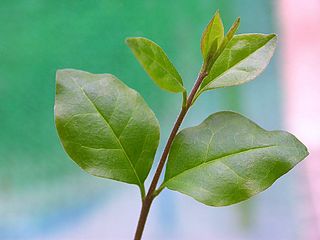
Ligustrum sinense is a species of privet native to China, Taiwan and Vietnam, and naturalized in Réunion, the Andaman Islands, Norfolk Island, Costa Rica, Honduras, Panamá and much of the eastern and southern United States. The name "Chinese privet" may also refer to Ligustrum lucidum.
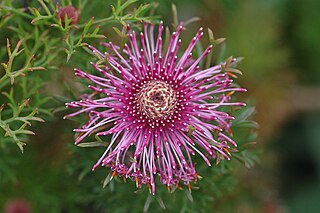
Isopogon formosus, commonly known as rose coneflower, is a species of flowering plant in the family Proteaceae and is endemic to the south-west of Western Australia. It is a shrub with divided leaves with cylindrical segments, and spherical to oval heads of pink or red flowers.

Allium chinense is an edible species of Allium, native to China, and cultivated in many other countries. Its close relatives include the onion, shallot, leek, chive, and garlic.

Ligustrum obtusifolium is a species of privet, native to Japan, Korea and northeastern China. The species is considered invasive in parts of the United States. It has become very common in southern New England, the mid-Atlantic States, and the Great Lakes regions, with scattered occurrences in the South, the Great Plains, and Washington state. With Ligustrum ovalifolium it is a parent of the widespread hybrid Ligustrum × ibolium.

Empetrum nigrum, crowberry, black crowberry, or, in western Alaska, blackberry, is a flowering plant species in the heather family Ericaceae with a near circumboreal distribution in the northern hemisphere. It is also native in the Falkland Islands. It is usually dioecious, but there is a bisexual tetraploid subspecies, Empetrum nigrum subsp. hermaphroditum, that occurs in more northerly locations and at higher altitude.
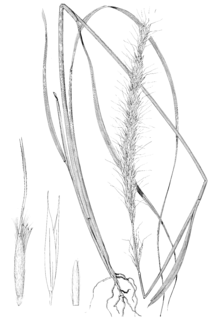
Achnatherum robustum, commonly known as sleepy grass, is a perennial plant in the Poaceae or grass family.
Ligustrum pricei is a species of Ligustrum, native to China and Taiwan, where it occurs at 900–1700 m altitude.
Conospermum acerosum, commonly known as needle-leaved smokebush, is a shrub endemic to Western Australia
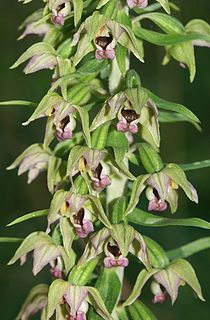
Epipactis helleborine, the broad-leaved helleborine, is a terrestrial species of orchid with a broad distribution. It is a long lived herb which varies morphologically with ability to self-pollinate.
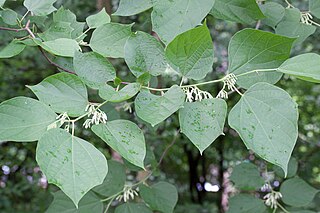
Alangium chinense is a species of flowering plant in the Cornaceae family. It has the Chinese name.
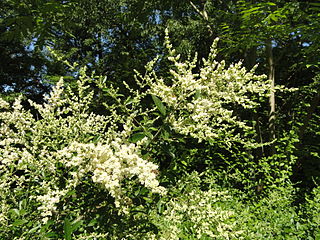
Ligustrum quihoui is a shrub native to Korea and China. As with some other members of the genus, L. quihoui is cultivated as an ornamental in many places and has become naturalized and invasive in urban areas and scattered forested locales of the southeastern United States.

Persicaria chinensis, commonly known as creeping smartweed or Chinese knotweed, is a plant species from the family Polygonaceae. It is widespread across China, Japan, the Indian Subcontinent, Indonesia, Malaysia, and Vietnam. It is a common plant in Malaysia and Vietnam, where it is used in herbal remedies, such as for the treatment of dysentery, enteritis, and sore throat. It is a weed in some coastal areas of New South Wales and Queensland in Australia.

Acer pictum subsp. mono, commonly known as painted maple or mono maple in English, itayakaede (板屋楓) or ezoitaya (蝦夷板屋) in Japan, 五角枫 in China, or gorosoe (고로쇠) or gorosoenamul (고로쇠나무) in Korea, is a species of maple.

Ligustrum robustum grows as a shrub or small tree up to 10 m (30 ft) tall though old specimens of more than a hundred years have been observed with a height of 15 m (50 ft). The fruit of the shrub is an ellipsoid berry, bluish-purple when fully ripe, 7–10 mm (0.28–0.39 in) × 4–5 mm (0.16–0.20 in).

Syringa pubescens is a species of flowering plant in the lilac genus of the family Oleaceae, native to Korea and China.

















